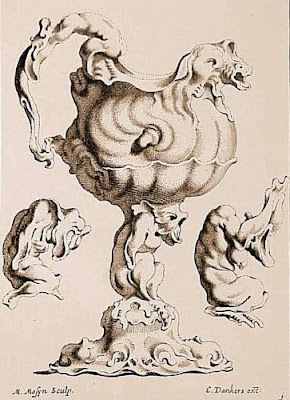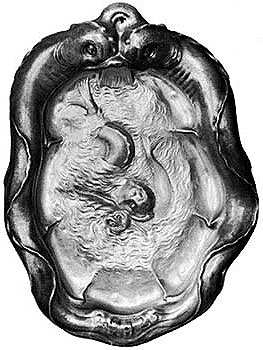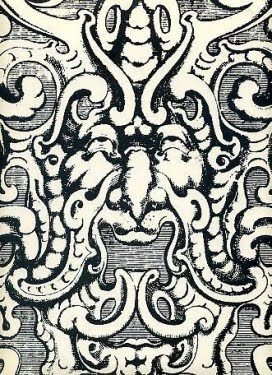German Knorpelwerk or Ohrmuschelstil, Dutch kwabornament. A 17th-century ornamental style based on the human ear and other gristly parts.
 |
| Kwabornament Mosyn of Amsterdam, Designs in Auricular Style, 1620 |
The auricular style was invented in the early 17th century by Dutch silversmiths and brothers Paulus and Adam van Vianen. Paulus was inspired by anatomy lectures he attended in Prague, and both he and Adam became known for the style, which was made popular by Johannes Lutma.
Auricular ornament refers to a lobe-like decoration, like a thick dripping substance apparently resembling organic shapes. The word auricular refers to the ear, in particular to the earlobes. In the 17th century auricular ornamentation was known as "fratsen en snaeckerijen" (whimsy and drollery). Auricular ornament originated in the late-16th century as a two-dimensional form in ornamental prints. During the following century it was employed as a three-dimensional decorative element in window frames and picture frames. The silversmith Paulus van Vianen (1570-1613) used it so frequently that it became his trademark. When Paulus died, his brother Adam was commissioned to make a commemorative piece. He made a ewer as one continuous auricular design, thereby raising auricular ornament to a form in its own right (Shafe).
Auricular describes a type of ornament popular in the 17th century, characterized by smooth, curved and rippling forms resembling the human ear. This highly plastic style evolved during the first two decades of the 17th century in Utrecht, and in its fully developed form is found only in metalwork. The style in this medium is characterized by the use of amorphous, lobate scrolls and embossed, relief ornament that emphasize the malleable nature of the metal. At its most extreme, it exaggerates this quality by suggesting that objects were modelled in a semi-molten state. The goldsmiths Adam van Vianen and Paulus van Vianen of Utrecht are often credited with the invention of the style, although its origins seem to lie in the graphic designs of such 16th-century Italian Mannerist artists as Giulio Romano (e.g. drawing for a fish-shaped ewer; Oxford, Christ Church) and Enea Vico. The latter's designs for plate were published in the mid-16th century and may have been known in Utrecht (Oxford Grove Art).
The auricular style was adopted by cabinetmakers and carvers in both the Low Countries and Germany. In the Netherlands it was cultivated by Michel Mosyn of Amsterdam and Johannes Lutma; subsequently was developed in Germany by Friedrich Unteutsch and Johann Heinrich Keller.
Applied to chair backs, frames, cupboards, and other surfaces, the gruesome, curving motifs consisting of bones, membranes, and cartilage were arranged in baroque arabesques, suggesting the ear-like lobular qualities after which the style is named.
The flabby, fleshy forms were sometimes contorted into masks, as shown in the Neues Zieratenbuch (New Ornamentation Book) of the designer Friedrich Unteutsch of Frankfurt am Main.
Extravagant Monstrosities
Gold- and Silversmith Designs in the Auricular Style
by Femke Speelberg
One of the most curious styles to become fashionable in early seventeenth-century gold- and silversmith work is the so-called Auricular Style. The name derives from the style's characteristic idiom of organic fluid lines, shapes, and smooth surfaces, often reminiscent of cartilage and, in particular, the curvature of the ear. At first glance, the basic structure of artworks executed in the Auricular Style gives the impression of an object that has come out of its mold unsuccessfully. When studied more closely, however, the various forms and creatures that emerge from the solidified, organic mass—masks, (parts of) human figures and animals, including ray fish, slugs, and dragons—form convincing evidence of exactly the opposite. In fact, in most cases, the objects were not made by casting at all. They were fashioned, instead, from a smooth (silver) plate that was meticulously worked into intricate compositions using a hammer and chisels.
Many of the sometimes eerie qualities of the Auricular Style had already emerged in the arts of the previous century. References to the monstrous world of invertebrates and reptiles were a recurrent phenomenon in the ceramic creations of the workshop of Bernard Palissy (1510–1590); the Flemish grotesque designs of Cornelis Floris II (before 1514–1575) and Cornelis Bos (ca. 1510?–before 1566); and the artificial grottoes that adorned the gardens and houses of rich Italian families. The flowing, organic base structure of the designs is reflected in vessels made from natural stones (17.190.536) and other luxury objects fashioned from exotic objects such as shells and pearls.
The Auricular Style that emerged in the early seventeenth century went through its own distinct development, however, and—although used for various types of objects, including picture frames and gilt leather wallpaper—was connected in particular to the Dutch silver- and goldsmith trade. The great popularity of the style is usually explained by the Renaissance curiosity for the natural world, and the emergence of scientific research. The organic shapes, in particular, suggest that anatomical study and dissection played a significant part in the development of the characteristic idiom of the Auricular Style. Similar to anatomical abnormalities and exotic animals and objects, the appeal of these pieces therefore also lay in their role as objects of wonder, made for the elite to marvel at like many other treasures found in a so-called Kunst- und Wunderkammer.
Artists. Paulus Willemsz van Vianen (c. 1570–c. 1613/14), Adam van Vianen (c. 1568/69–1627), Gerbrand van den Eeckhout (1621–1674), and Johannes Lutma the Elder (1584–1669).
Blossoming in Print. Although a relatively large number of silver objects in the Auricular Style survive, a great many more designs are known because they were spread through prints, initially produced by descendants of the great masters. One of the earliest print series with Dutch Auricular designs was published by Christiaen van Vianen (c. 1598–1671). Under the alluring title Artful Models of Various Silver Vases and Other Capricious Works, he presented the ingenuity and breadth of his father's designs to the world. Jacob Lutma (c. 1624–1654), son of Johannes Lutma the Elder, soon followed suit with a series celebrating the works of his father. The great appeal of these works inspired print publishers to compile other series of Auricular designs. Cornelis Danckertsz I (c. 1603–1656), for example, combined designs by all the great protagonists of the style in one series entitled Various Artful Inventions to be Applied in Gold, Silver, Wood, and Stone. Although the print run for most of these series seems to have been limited, the multilingual title pages suggest that they were meant to be distributed throughout the European continent. Christiaen van Vianen chose to print his titles in Italian, French, and Dutch, all of which he economically placed on the same page. In contrast, the Amsterdam publisher Clement de Jonghe decided it was worth his while to produce three individual title pages for the series of Auricular cartouches by Gerbrand van den Eeckhout. Most other existing copies of the series suggest that only one of the title pages, in Dutch, French, or Latin, would be chosen to accompany the designs, depending on the intended customer(s).
The publication of Auricular designs did not occur when the style first emerged in the early seventeenth century, but rather in the late 1640s and 1650s, toward, or in some cases even well after, the end of the artists' careers. This is generally thought to have something to do with the protection of artistic and intellectual property. At the same time, however, it also proved very beneficial to the descendants and followers of Paulus and Adam van Vianen and Johannes Lutma the Elder, as the publication of the designs in prints spurred a renewed interest and demand for designs in this style which they gladly provided (MET-NY).
Resources
• Akerman, Luis Mariano. Francis Bacon y lo Grotesco, lecture, Buenos Aires, Universidad de Belgrano, August 2009
• Auricular Ornament, Rijksmuseum, Holland, accessed 25.9.2012
• Auricular Style, Encyclopaedia Britannica, United Kingdom, accessed 20.12.2010
Auricular Style, Oxford Grove Art, United Kigdom, accessed 25.9.2012
• Grotesques, Dictionnaire de la peinture Larousse, France, accessed 3.11.2010
• Guilmard, Désiré. Les maîtres ornemanistes, Paris, 1880-1
• Shafe, Laurence. Early Stuart: Tapestry and Goldsmith Work, History of Art, 2006
• Singleton, Esther. The Dutch and Flemish Furniture, The McClure Company, 1907, The Duch Home, Part 9
• Speelberg, Femke. Extravagant Monstrosities: Gold- and Silversmith Designs in the Auricular Style, Heilbrunn Timeline of Art History, New York: The Metropolitan Museum of Art, 2000–14
• Wikimedia Commons
 |
| Christiaen van Vianen, Silver Dish in Auricular Style, 1635 Victoria & Albert Museum, London |
Auricular ornament refers to a lobe-like decoration, like a thick dripping substance apparently resembling organic shapes. The word auricular refers to the ear, in particular to the earlobes. In the 17th century auricular ornamentation was known as "fratsen en snaeckerijen" (whimsy and drollery). Auricular ornament originated in the late-16th century as a two-dimensional form in ornamental prints. During the following century it was employed as a three-dimensional decorative element in window frames and picture frames. The silversmith Paulus van Vianen (1570-1613) used it so frequently that it became his trademark. When Paulus died, his brother Adam was commissioned to make a commemorative piece. He made a ewer as one continuous auricular design, thereby raising auricular ornament to a form in its own right (Shafe).
 |
| Adam van Vianen, Jar in auricular style, 1614 Rijksmuseum, Amsterdam |
Auricular describes a type of ornament popular in the 17th century, characterized by smooth, curved and rippling forms resembling the human ear. This highly plastic style evolved during the first two decades of the 17th century in Utrecht, and in its fully developed form is found only in metalwork. The style in this medium is characterized by the use of amorphous, lobate scrolls and embossed, relief ornament that emphasize the malleable nature of the metal. At its most extreme, it exaggerates this quality by suggesting that objects were modelled in a semi-molten state. The goldsmiths Adam van Vianen and Paulus van Vianen of Utrecht are often credited with the invention of the style, although its origins seem to lie in the graphic designs of such 16th-century Italian Mannerist artists as Giulio Romano (e.g. drawing for a fish-shaped ewer; Oxford, Christ Church) and Enea Vico. The latter's designs for plate were published in the mid-16th century and may have been known in Utrecht (Oxford Grove Art).
 |
| Johannes Lutma Cartouche auriculaire, Amsterdam, 1633-54 BnF Paris |
The auricular style was adopted by cabinetmakers and carvers in both the Low Countries and Germany. In the Netherlands it was cultivated by Michel Mosyn of Amsterdam and Johannes Lutma; subsequently was developed in Germany by Friedrich Unteutsch and Johann Heinrich Keller.
 |
| Unteutsch, Knorpelwerk, 1650 |
Applied to chair backs, frames, cupboards, and other surfaces, the gruesome, curving motifs consisting of bones, membranes, and cartilage were arranged in baroque arabesques, suggesting the ear-like lobular qualities after which the style is named.
 |
| Keller, Knorpelgrotesk, 1680 |
The flabby, fleshy forms were sometimes contorted into masks, as shown in the Neues Zieratenbuch (New Ornamentation Book) of the designer Friedrich Unteutsch of Frankfurt am Main.
 |
| Knorpelwerk Decorative frame in cartilaginous style Germany, 17th century |
Extravagant Monstrosities
Gold- and Silversmith Designs in the Auricular Style
by Femke Speelberg
One of the most curious styles to become fashionable in early seventeenth-century gold- and silversmith work is the so-called Auricular Style. The name derives from the style's characteristic idiom of organic fluid lines, shapes, and smooth surfaces, often reminiscent of cartilage and, in particular, the curvature of the ear. At first glance, the basic structure of artworks executed in the Auricular Style gives the impression of an object that has come out of its mold unsuccessfully. When studied more closely, however, the various forms and creatures that emerge from the solidified, organic mass—masks, (parts of) human figures and animals, including ray fish, slugs, and dragons—form convincing evidence of exactly the opposite. In fact, in most cases, the objects were not made by casting at all. They were fashioned, instead, from a smooth (silver) plate that was meticulously worked into intricate compositions using a hammer and chisels.
Many of the sometimes eerie qualities of the Auricular Style had already emerged in the arts of the previous century. References to the monstrous world of invertebrates and reptiles were a recurrent phenomenon in the ceramic creations of the workshop of Bernard Palissy (1510–1590); the Flemish grotesque designs of Cornelis Floris II (before 1514–1575) and Cornelis Bos (ca. 1510?–before 1566); and the artificial grottoes that adorned the gardens and houses of rich Italian families. The flowing, organic base structure of the designs is reflected in vessels made from natural stones (17.190.536) and other luxury objects fashioned from exotic objects such as shells and pearls.
The Auricular Style that emerged in the early seventeenth century went through its own distinct development, however, and—although used for various types of objects, including picture frames and gilt leather wallpaper—was connected in particular to the Dutch silver- and goldsmith trade. The great popularity of the style is usually explained by the Renaissance curiosity for the natural world, and the emergence of scientific research. The organic shapes, in particular, suggest that anatomical study and dissection played a significant part in the development of the characteristic idiom of the Auricular Style. Similar to anatomical abnormalities and exotic animals and objects, the appeal of these pieces therefore also lay in their role as objects of wonder, made for the elite to marvel at like many other treasures found in a so-called Kunst- und Wunderkammer.
Artists. Paulus Willemsz van Vianen (c. 1570–c. 1613/14), Adam van Vianen (c. 1568/69–1627), Gerbrand van den Eeckhout (1621–1674), and Johannes Lutma the Elder (1584–1669).
Blossoming in Print. Although a relatively large number of silver objects in the Auricular Style survive, a great many more designs are known because they were spread through prints, initially produced by descendants of the great masters. One of the earliest print series with Dutch Auricular designs was published by Christiaen van Vianen (c. 1598–1671). Under the alluring title Artful Models of Various Silver Vases and Other Capricious Works, he presented the ingenuity and breadth of his father's designs to the world. Jacob Lutma (c. 1624–1654), son of Johannes Lutma the Elder, soon followed suit with a series celebrating the works of his father. The great appeal of these works inspired print publishers to compile other series of Auricular designs. Cornelis Danckertsz I (c. 1603–1656), for example, combined designs by all the great protagonists of the style in one series entitled Various Artful Inventions to be Applied in Gold, Silver, Wood, and Stone. Although the print run for most of these series seems to have been limited, the multilingual title pages suggest that they were meant to be distributed throughout the European continent. Christiaen van Vianen chose to print his titles in Italian, French, and Dutch, all of which he economically placed on the same page. In contrast, the Amsterdam publisher Clement de Jonghe decided it was worth his while to produce three individual title pages for the series of Auricular cartouches by Gerbrand van den Eeckhout. Most other existing copies of the series suggest that only one of the title pages, in Dutch, French, or Latin, would be chosen to accompany the designs, depending on the intended customer(s).
The publication of Auricular designs did not occur when the style first emerged in the early seventeenth century, but rather in the late 1640s and 1650s, toward, or in some cases even well after, the end of the artists' careers. This is generally thought to have something to do with the protection of artistic and intellectual property. At the same time, however, it also proved very beneficial to the descendants and followers of Paulus and Adam van Vianen and Johannes Lutma the Elder, as the publication of the designs in prints spurred a renewed interest and demand for designs in this style which they gladly provided (MET-NY).
Resources
• Akerman, Luis Mariano. Francis Bacon y lo Grotesco, lecture, Buenos Aires, Universidad de Belgrano, August 2009
• Auricular Ornament, Rijksmuseum, Holland, accessed 25.9.2012
• Auricular Style, Encyclopaedia Britannica, United Kingdom, accessed 20.12.2010
Auricular Style, Oxford Grove Art, United Kigdom, accessed 25.9.2012
• Grotesques, Dictionnaire de la peinture Larousse, France, accessed 3.11.2010
• Guilmard, Désiré. Les maîtres ornemanistes, Paris, 1880-1
• Shafe, Laurence. Early Stuart: Tapestry and Goldsmith Work, History of Art, 2006
• Singleton, Esther. The Dutch and Flemish Furniture, The McClure Company, 1907, The Duch Home, Part 9
• Speelberg, Femke. Extravagant Monstrosities: Gold- and Silversmith Designs in the Auricular Style, Heilbrunn Timeline of Art History, New York: The Metropolitan Museum of Art, 2000–14
• Wikimedia Commons
Additional Material
• Auricular Style
• Rijksstudio Akermariano
• Kwabornament, V&A, Rijksmuseum, Museumnetwork, Old Book Illustrations, BibliOdyssey, Framing Charles II, Victorian jug, DeVille.
• The Auricular Style: Frames Conference, Wallace Collection, 5-6 October 2016
• The Grotesque Times






